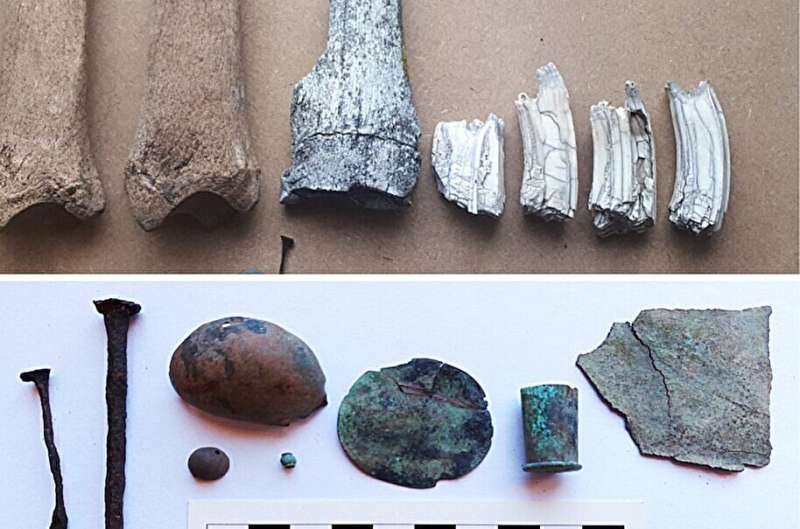This article has been reviewed according to Science X's editorial process and policies. Editors have highlighted the following attributes while ensuring the content's credibility:
fact-checked
peer-reviewed publication
trusted source
proofread
Anthropologist finds South American cultures quickly adopted horses

A new study from a University of Colorado Boulder researcher, conducted with colleagues in Argentina, sheds new light on how the introduction of horses in South America led to rapid economic and social transformation in the region.
William Taylor, an assistant professor of anthropology and curator of archaeology in the Museum of Natural History at CU Boulder, says this research shows that the story about people and horses in the Americas is "far more dynamic" than previously thought.
"Our findings from Patagonia show that the spread of horses, the emergence of horse-based ways of life in the southernmost areas of South America, was both rapid and largely independent of European control," says Taylor, who has studied horses since 2011. "From almost their first arrival on the shores of the Americas in the 16th century, horses had an impact at a continental scale."
Juan Bautista Belardi, a professor of archaeology at the Universidad Nacional de la Patagonia Austral in Argentina and Taylor's research colleague, and his team in Patagonia conducted all the field research at a canyon site called Chorrillo Grande 1 in southern Argentina. They unearthed the remains of an Aónikenk/Tehuelche campsite (people of the Indigenous Tehuelche nation traditionally used horses for hunting, transportation, warfare and food) that included horse bones, artifacts and metal ornaments.
Belardi says he believes the Chorrillo Grande 1 camp is just one of the many archaeological sites spread across the canyon.
"As far as we can tell, the human occupation of the canyon started at least around 3,500 years ago," Belardi says. "This is very important, because it allows us to model how hunter-gatherers used the landscape."
An introduction to horses
Taylor and his colleagues at CU Boulder then used DNA sequencing, radiocarbon dating and isotope analysis on the items Belardi's team uncovered.
"The use of genetic and isotopic data showed a life history of the horses, where they were raised and their mobility between valleys," Belardi says. "Horses changed the way hunter-gatherers used the landscape and, of course, this has had great influences on social and ideological life."
Taylor and Belardi say that when hunter-gathers first encountered horses, they were quick to begin using them.
"The advantages clearly showed up as soon as people had horses—the chance to save energy riding them, to extend the radius of hunting parties, less time needed to find prey and the ease to transport things, among others," Belardi says. "Plus, horses could be consumed and their hides used. It was a great change that impacted all economic and social aspects of life in Patagonia."
Taylor says horses reshaped the landscape of the ancient world by connecting people across vast distances; by transforming the grasslands into thriving cultural, economic and political centers; and during colonization, they helped maintain sovereignty for many peoples around the world.
"Even in 2023, these roles and impacts are still visible just under the surface of the world around us," Taylor says.
Taylor first became interested in studying what he calls the "human-horse story" as a way of understanding his family and its past.
"My grandfather was a cowboy, and my dad grew up with horses, but I'm from the first generation in my family that didn't," Taylor says. "So, when I got into the study of the ancient world, I was immediately drawn to understanding people and horses."
One of his first experiences as a student was studying the skeleton of a 2,500-year-old horse. "After that, I became curious about everything I could learn about people by studying horse remains. Living in places like Montana or Colorado today, we're still in a legacy horse culture."
He also has a book coming out later this year from the University of California Press, telling the global history of the human-horse story called Hoof Beats: How Horses Shaped Human History.
Taylor says he views this latest research as "not yet completed" and hopes that the study will serve as a platform for launching researchers toward a wider investigation of the role of horses in ancient Argentina and South America.
"We hope to build on this work to continue to collaboratively explore the role of horses in shaping life in Patagonia and Argentina," he says, "and connect this record with our research in other parts of the ancient world."
More information: William Timothy Treal Taylor et al, Interdisciplinary evidence for early domestic horse exploitation in southern Patagonia, Science Advances (2023). DOI: 10.1126/sciadv.adk5201
Journal information: Science Advances
Provided by University of Colorado at Boulder



















